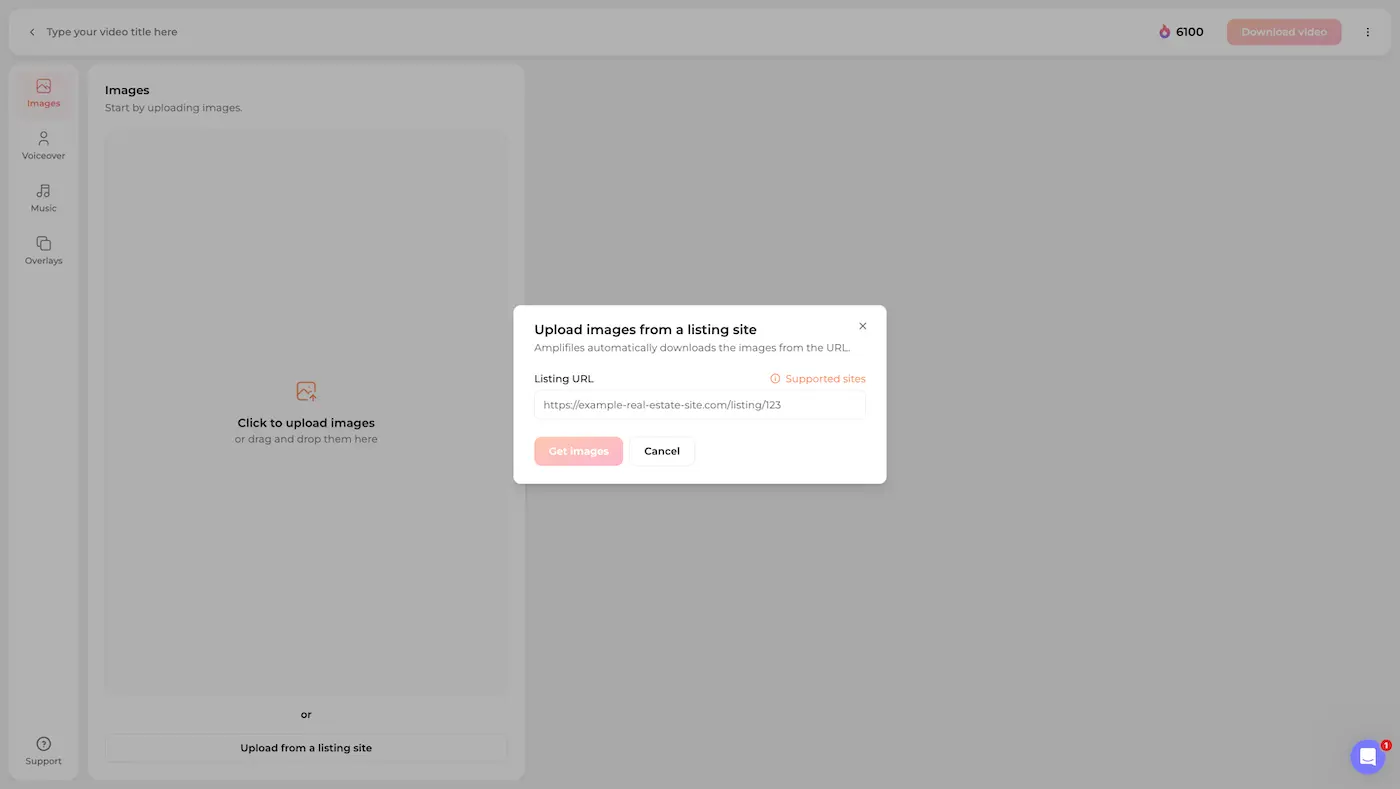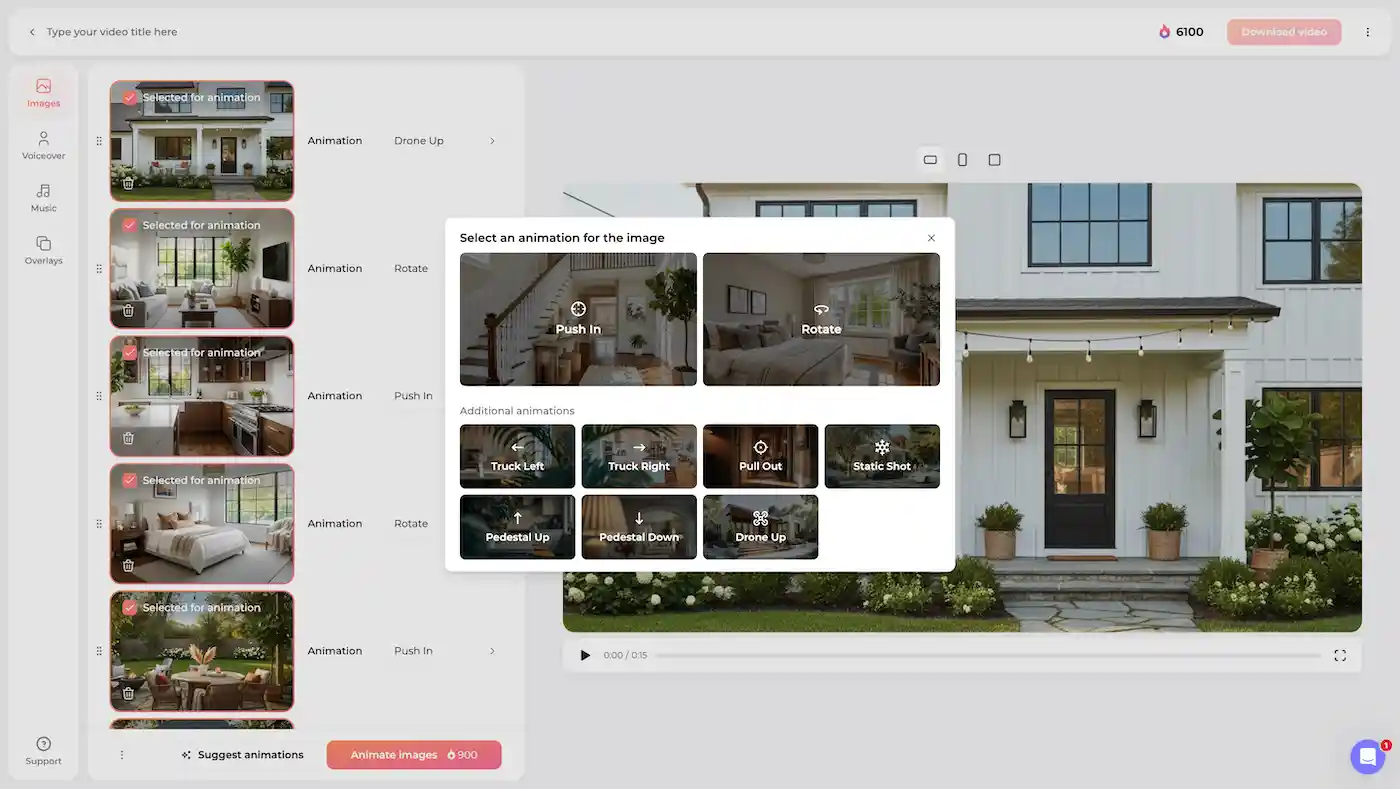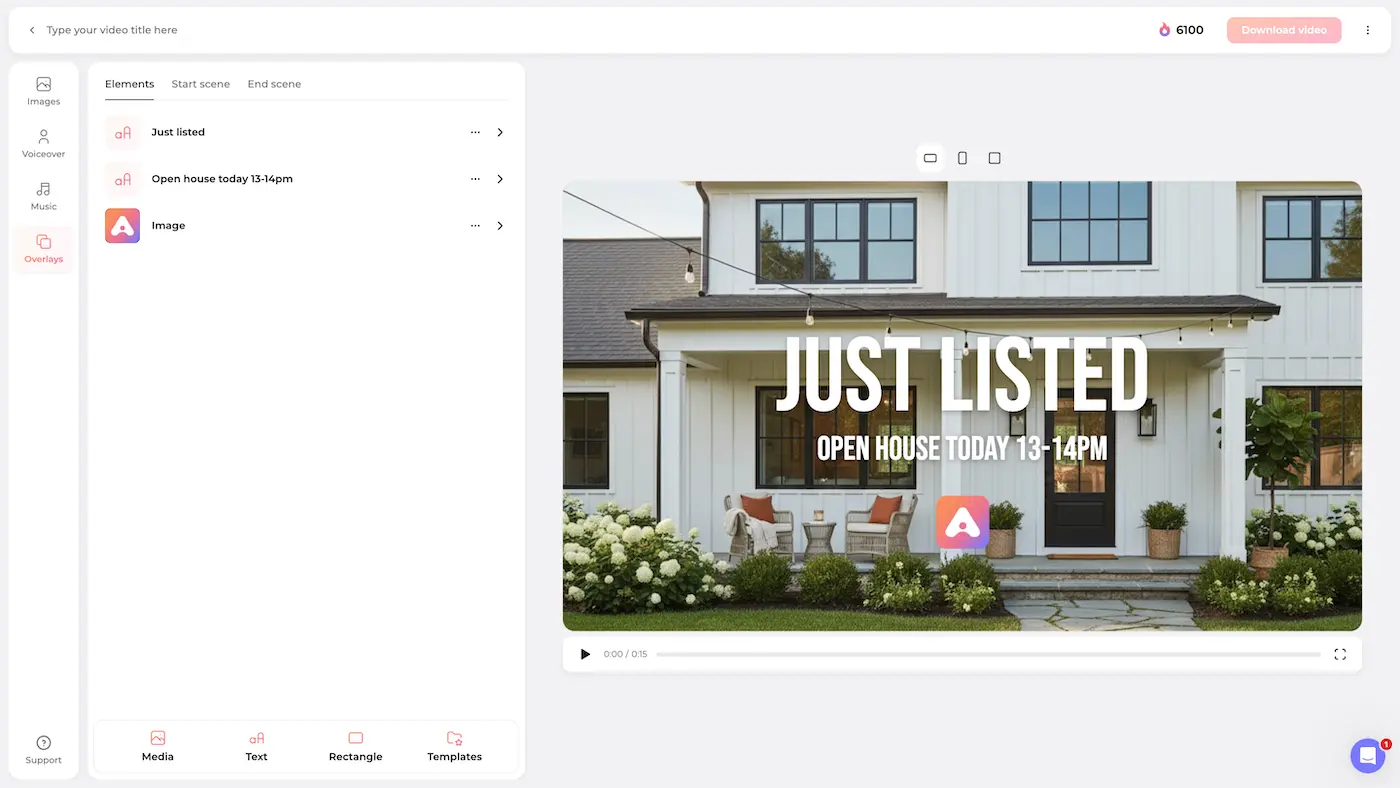
Video is now the most powerful way to market a property. Buyers expect it, sellers value it, and algorithms reward it. Yet many have skipped it because traditional production is slow and costly. AI real estate videos will change that. With the right tools, listing photos can be transformed into polished walkthroughs in minutes, making video marketing affordable, scalable, and effective for every listing.
Key Takeaways:
AI real estate video has made property marketing faster, cheaper, and easier to scale. Instead of hiring crews or waiting on edits, agents can now turn listing photos into ready videos in minutes.
- Lower cost and faster results - AI real estate video generators create professional content for just a few dollars per listing.
- Every home can have video - video marketing is no longer limited to high-end properties.
- Tools to choose from - most offer free trials and flexible pricing models to make getting started easy.
- Agent control stays central - AI does the heavy lifting, but humans add personal touches to keep videos authentic.
The Rise of AI Video in Real Estate Marketing
With no surprise, AI video technology is rapidly gaining traction in real estate marketing. Agents and agencies recognize its potential to transform traditional methods of producing video. It is what buyers and sellers expect. According to the National Association of Realtors, 73% of homeowners prefer to work with an agent who uses video to market their home.
Videos are expected in listings for a good reason. Hemnet, a leading property portal in Sweden, studied how video impacts engagement. Listings with video had 44% more viewing time, 76% more shares, and 31% more saves compared to photo only listings. In other words, video gets buyers to stop scrolling and sellers to feel that their home is being marketed seriously.
Yet despite its proven impact, video has not been the norm. Traditional real estate videography involves booking a crew, scheduling shoots, waiting on edits, and paying hundreds or even thousands per property. That workflow makes sense for a high value listing but it eats margins on lower priced homes.
This is where AI real estate video tools have flipped the equation.
What Is an AI Real Estate Video Editor?
An AI real estate video editor is software that automatically turns listing photos or short clips into ready-to-share videos. Instead of editing by hand, the system analyzes each image, applies camera movement, captions, transitions, and syncs everything with music or voiceover. The goal is to help agents produce professional videos in minutes without touching a timeline.
Each tool uses slightly different AI models. Some rely on visual recognition models that detect room types or angles, while others use large language models (LLMs) to generate captions, scene descriptions, or voiceover scripts. The mix of models determines how natural the pacing, motion, and storytelling feel in the final video.
For real estate, this means every property - not just high-budget listings - can have professional video content. The process is fast, affordable, and consistent, making it practical to share videos across MLS, social media, and email campaigns. Tools like Amplifiles combine image analysis with motion prediction to select camera movements and clip timing that match each scene, so the end result looks natural without manual editing.
Once you understand what these tools do, the next question is why agents are adopting them so quickly.
Why Real Estate Agents Are Adopting AI Video Editors
AI real estate video editors have removed the biggest friction points of traditional video marketing: time, cost, and complexity. Instead of hiring a crew or learning editing software, agents can now produce listing videos directly from photos using automated motion, captions, and voiceover.
Here is what makes them practical for everyday marketing:
- Time savings: A complete property video can be produced in minutes. Upload photos, let the AI handle motion and pacing, and download a ready to use clip without manual editing or post production.
- Cost efficiency: Traditional videography costs hundreds per listing. In tools like Amplifiles, you pay only per image, for example $1.50 each. That means a 7 image listing video costs about $10.50, making video affordable for every property.
- Professional polish: AI tools ensure smooth pacing, natural transitions, and consistent visual quality, even if you have never edited before.
- Scalability: Because production is automated, every home, not just premium listings, can have professional video coverage.
- Consistent brand presence: When video creation becomes quick, it is easy to post regularly across MLS, social media, and email campaigns, keeping your brand visible.
Together, these benefits explain why AI video editors are quickly becoming part of standard listing workflows. Video marketing finally scales.
Cost of AI Real Estate Video vs Traditional Production
- Traditional videography: $300-$1,000+ per listing (crew, shoot, edit).
- AI real estate video: $1–$2 per image, or $20–$100/month subscriptions.
- Result: Every listing can afford video, not just high-end homes.
In Practice: How AI Real Estate Video Editor Works
Here’s what the process looks like in Amplifiles. The steps are simple, and each takes only a few seconds. You upload your photos, choose style and format, and the system automatically creates a ready video that you can share to MLS or social channels.
1. Add listing photos
Upload listing photos or fetch them from a listing URL. The editor analyzes images and suggests motion automatically if the user selects that option, preparing each image for smooth camera movement.

2. Add motions to photos
Select camera movements yourself or let AI suggest the best motion and pacing. Each photo gets smooth transitions that make the video feel natural.

3. Add branding elements
Add your logo, agent name, and contact info. You can also include background music or AI generated voiceovers in your chosen language.

4. Preview, adjust and choose format
Preview your video before export and make quick adjustments if needed. Choose format and style, vertical for Reels and TikTok, horizontal for YouTube or MLS pages, or square for ads. The final export is a ready 1080p video.

Once ready, videos can be shared on social media, embedded in property pages, or added to newsletters. AI real estate video editors like Amplifiles automate the heavy lifting but still give users full control to fine tune the final look. This balance between automation and creativity makes AI video tools practical for everyday real estate marketing.
Use of AI Real Estate Videos in Marketing
Once the video is ready, agents can use it across every part of their marketing plan - from listings to social media and email campaigns. The most practical application for AI in real estate is listing video, but its value goes far beyond a single clip. Agents can quickly create multiple versions of the same property video to A/B test different hooks or styles, or produce videos in different languages to reach international buyers. From listings to social media and even lead nurturing campaigns, AI video gives you the flexibility to market smarter and connect with a wider audience.
For agents, a property that would never justify the cost of traditional videography can now be marketed with video. On social media, AI tools make short clips for Reels, TikTok, and Facebook fast to produce. Email campaigns also benefit when you embed video and drive more clicks.
For photographers, this is a new income stream. You already have the photos. Turning them into a 15-30 second reels or a longer walkthrough is a quick upsell that adds value for clients and margin for you. One photo set can easily produce an MLS video, short social teasers, and a branded reel for the agent.
Concerns about AI Videos in Real Estate Industry
AI makes video creation faster and more accessible, but it is not 100% flawless. These tools are designed to support humans, not replace them, which means users still play the key role of reviewing content and making final decisions.
- Hallucinations or misrepresentation: General purpose AI might generate details that do not exist. Real estate AI video editors like Amplifiles are trained on listing content which minimizes errors. Agents can also reanimate, crop, or edit before publishing.
- Unnatural pacing: Some AI videos run too fast, not giving buyers enough time to absorb details. For example in Amplifiles, adjustable animation speed and clip duration solve this.
- Loss of human touch: Automated videos risk feeling generic. Adding logos, agent photos, or custom voice-overs restores personality and brand identity.
The key insight is that AI is there to do the heavy lifting but the agent remains in control. These tools support humans. They do not replace them.
AI Real Estate Video Tools to Try

Real estate focused AI tools usually need less cleanup and fit listing workflows better than general AI video apps. They are also simple to use. Here’s a quick shortlist of options to explore:
Customer reactions have already shown how powerful the adaptation to new tools has been. For example in Amplifiles, 94% of users liked their very first video. Many come in with low expectations based on past experiences with AI but the combination of speed, quality, and ease of use wins them over.
Lessons Learned & Best Practices
Through real world use, a few lessons have become clear in use of AI real estate video editors. When it comes to producing high quality and impactful videos:
- Keep it short: Do not just drop 30 photos into one video. Attention spans are short. Create multiple versions such as short reels for social media and longer walkthroughs for YouTube or virtual tours.
- Review before publishing: AI is powerful but not perfect. Always check for details, pacing, and flow.
- Experiment with styles: Re animate images, adjust speed, and try different motion effects. A mix of push ins, pans, and rotations keeps viewers engaged.
- Start with good photos: AI video cannot fix poor photography. The better the source images, the better the final video.
Future of AI Video in Real Estate
The direction is clear. Early adopters including agents and brokerages are already using AI real estate videos in their standard marketing. Over time it will become as expected as professional photos.
Those who do not adapt risk being left behind. Sellers will naturally prefer agents who can offer video because it means more visibility for their listing. With AI real estate video tools producing outputs that buyers cannot even recognize as AI made, the gap will only widen.
Innovation is also ongoing. Features like voice cloning, more advanced automation, and smarter model training are on the horizon. These upgrades will push AI video even closer to flawless while still leaving room for human review and creative input.
Frequently Asked Questions About the Topic
What is an AI real estate video generator?
It’s a tool that automatically creates property videos from listing photos. Instead of hiring a videographer, you upload images and the AI applies animations, transitions, captions, and voiceover to produce a professional-quality video in minutes.
How much does AI real estate video cost?
Costs vary depending on the platform. Traditional videography can run $300 - $1,000 per listing, while AI video tools are much cheaper. Some charge per image (around $1- $2 each), while others use subscription models starting at $20-$100 per month. Most platforms offer a free trial so you can test results before paying.
Are AI real estate videos effective on social media?
Yes. Short, vertical clips generated by AI are ideal for Instagram Reels, TikTok, and Facebook, where video content consistently outperforms static photos. Agents report higher engagement and more inquiries when videos are shared across social channels.
Does AI replace real estate videographers?
Not completely. AI tools are best for everyday listings where speed and affordability matter. Professional videographers still add value for luxury homes, brand campaigns, or when high-end custom storytelling is needed. For most listings, though, AI makes video practical and scalable.
Should I use AI video in listing presentations?
Absolutely. Showing sellers that every property will be marketed with video sets you apart from agents who only offer photos. It demonstrates modern marketing, builds trust, and helps win more listings.
Conclusion: Embracing AI Video for Real Estate Success
AI real estate video has moved from hype to practical reality in real estate marketing. It makes professional quality video accessible, fast, and affordable. Agents can now deliver video listings for every property, not just the high end, while photographers can expand their services and income streams.
The combination of AI efficiency and human oversight creates the best of both worlds: videos that are accurate, personal, and effective. As adoption spreads, AI real estate video will become standard and the industry professionals who embrace it now will have the advantage.
